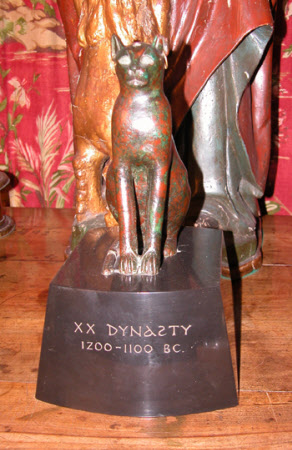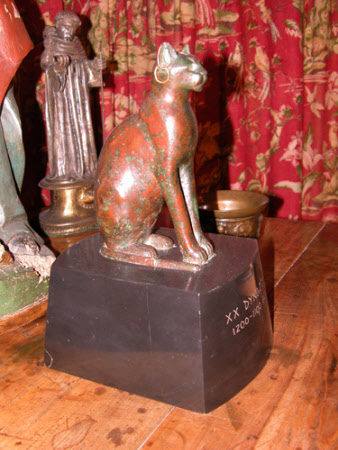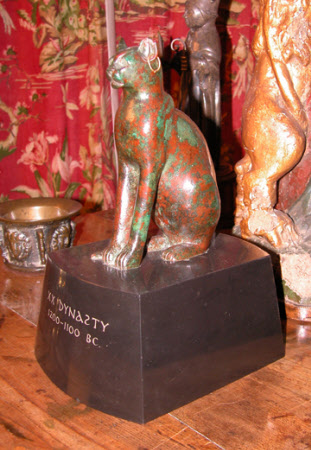Bastet
Egyptian
Category
Art / Sculpture
Date
700 BC - 400 BC
Materials
Bronze on basalt
Measurements
325 mm (Height)
Place of origin
Egypt
Order this imageCollection
Anglesey Abbey, Cambridgeshire
NT 514980
Summary
Bronze, the cat goddess Bastet, Egyptian (Late Period), c. 700-400 B.C. A bronze statuette of an Egyptian seated cat, representing the cat goddess Bastet, the deity of pregnancy and childbirth, who was also invoked for protection against contagious diseases and evil spirits. Bastet is depicted in a static seated pose, her tail, which has been broken, wrapped around her on the right. Above her eyes is an empty recess, which probably once contained an image of a scarab-beetle or kheper, in precious metal or stone. The whiskers and hairs around the mouth lightly incised in surface. Left ear is slightly damaged on inside, towards top, and tail has been broken. Some evidence of old corrosion. The cat is now mounted on a black marble base which states, wrongly, that this example of Bastet dates from the XX Dynasty of ancient Egypt, c. 1200-1100 B.C. In fact, the cat is in the style of the Late period, so may be dated to c. 700-400 BC. The gold earrings are a modern addition.
Full description
This fine statuette of the Egyptian goddess Bastet in the form of a seated cat was evidently regarded by Lord Fairhaven as one of the great finds of his collecting career. As part of a long journey on the yacht Sapphire that lasted from November 1924 to May 1925, and which took Lord Fairhaven and his party to the Far East, the party during its return journey stayed in Cairo in early March 1925. In the entry in his travel diary for Saturday 7 March 1925, Lord Fairhaven wrote that ‘I bought a fair sized bronze (Bast) a sworn antique which I trust it is, as I gave a large price for it’. The cat was bought from the shop of a dealer, Hatoum, in the Cairo Bazaar, which the Broughtons had already visited the day before, Lord Fairhaven writing that ‘We visited the shop of a man called Hatoum who had a most remarkable place filled to overflowing with jades, furniture, pottery, porcelain, [….] etc in prices from a few shillings to thousands of pounds…’ Lord Fairhaven subsequently had his bronze mounted on a black marble base on which he had recorded that the bronze figure was a product of the Egyptian 20th Dynasty, thus c.1200-1100 B.C. In fact, the goddess Bastet began to be depicted in the form of a cat in figurines such as this example only from c. 950 B.C.; the figure would appear therefore to be a product of the Late Period (712-323 B.C.), the final period in which the country was governed by native Egyptian rulers. There is evidence for domesticated cats being kept as pets in Egypt from around 1850 B.C., and they clearly played an important role in everyday Egyptian life. Depictions of cats in Egyptian art are very often symbolic, reflecting the belief of ancient Egyptians that their gods could manifest themselves in the form of familiar creatures, or natural or man-made objects. Cats were at first symbolic of the sun-god, but came increasingly to be associated with the goddess Bastet, originally conceived in the form of a fearsome lion. The image of the cat was a benevolent manifestation of this goddess, who formed part of the Hathor-Tefnut goddess cult, with its connections to worship of the sun and the eye of Re. She may also have been invoked in association with the process of childbirth and, more generally, as a protective deity. Innumerable amulets of cats in materials such as amethyst and cornelian survive, reflecting Bastet’s protective role. But there are also huge numbers of bronze figures of Bastet in the form of a cat, not just in the well-known seated form, but also as a standing or striding animal, and as a cat-headed standing figure of a woman. These statuettes, which vary greatly in their quality, bear witness to the vast production in Egypt during the first millennium B.C. of votive bronze figures, such statuettes being presented to temple sites literally in their thousands. One of the principal sites for worship of the goddess Bastet was Bubastis in the Nile delta. The Greek historian Herodotus, who visited Egypt in around 450 B.C., gave a vivid description of the annual festival in that town held in honour of the goddess (whom Herodotus identified with the Greek goddess Artemis): ‘When the time comes for the pilgrimage to Bubastis, great crowds of people, men and women together, pack themselves onto barges and sail off. Some of the women have castanets, with which they make a great clacking, and some of the men have flutes, which they play throughout the voyage, whilst the rest of the men and women sing and clap their hands… when they get to Bubastis, the pilgrims celebrate the festival by offering up a prodigious number of animal blood-sacrifices, and by drinking more wine over the course of the festivities than is consumed in the whole of the rest of the year. So many assemble, the locals claim, that the numbers come to 700,000 men and women – but no children.’ (Herodotus, The Histories, 2.60, trans. Tom Holland, London 2014, p.133). There was an enormous cat cemetery at Bubastis, which was very largely looted in the latter decades of the nineteenth century. It is quite possible therefore that the Anglesey Abbey cat, on the market in the early 1920s, had come from the Bubastis cat cemetery, but there were also many cat burials at other sites such as Saqqara and Giza, close to Cairo. Many of the figures of Bastet were made in bronze, but statuettes were also made in other materials, for example, one in chloritite with electrum-incrusted eyes, recently acquired by the Musée du Louvre, Paris (Grand Galerie. Le Journal du Louvre, no. 46, Winter 2018-19, p. 18). Largely as a result of the looting of the cemeteries at Bubastis and elsewhere, quite a few of the bronze figures had come on to the market in Egypt in the first decades of the 20th century. One in the Ashmolean Museum, Oxford (Inv. AN 1933.1694) was bequeathed by the pioneering Assyriologist Archibald Sayce (1845-1933), who began to work in Egypt in the early 1900s. A similar provenance has been mooted for the most celebrated bronze figure of the seated Bastet, the Gayer-Anderson Cat in the British Museum (Inv. EA 64391; Neal Spencer, The Gayer-Anderson Cat, British Museum Objects in Focus, London 2007). The Gayer-Anderson Cat is much larger than other bronze seated cats, roughly life-size, and is extensively decorated, with an embossed scarab beetle on its forehead, and a four-part collar over which is a necklace with a silver plaque of the religious symbol of the udjat-eye. Like the Anglesey Abbey cat, the eye sockets are empty. In both bronze figures, the cavities would originally have been inlaid with eyes made from another material, glass, faience ceramic, rock crystal or another hard stone or silver. The cavity in the forehead of the Anglesey Abbey cat would likewise originally have contained an insert in another material, probably also a representation of a scarab beetle. Scarabs were important religious and funerary symbols in ancient Egypt, embodying the rising sun and believed also to be a manifestation of the god Khepri. The scarab beetle, which lays its eggs in dung which it then rolls along into a larger ball held between its forelegs, came to be seen as a symbol of rebirth and of autogenesis, since the beetle’s eggs will eventually hatch from the dung balls, suggestive of the new beetle emerging from the very earth. The links with the sun and with the god Khepri, who as a scarab pushed the sun across the skies, came from the common belief that the beetle’s course with its dung ball was from east to west, following the sun. It is difficult to date the bronze figures of cats and impossible to do so with any precision. The most important reference piece is another one in bronze in the Musée du Louvre, Paris (Inv. E 2533), which bears an inscription with the name of the king Psamtek I (664-610 B.C.). The probable date of the Gayer-Anderson Cat is 664-525 B.C. but it could have been made any time up to c. 300 B.C. The Anglesey Abbey cat may also be fitted within the broad date range of the Egyptian Late period. When acquired by Lord Fairhaven, his bronze statuette of Bastet was missing the gold earrings which the cat would originally have worn. The current earrings were added as recently as 1989, the gift of an Anglesey Abbey volunteer, Mr. John Newson. Jeremy Warren 2019
Provenance
Purchased by Huttleston Rogers Broughton, 1st Lord Fairhaven (1896-1966) from Hatoum, antiquities dealer in the bazaar, Cairo, on 7 March 1925; listed in the Anglesey Abbey inventory 1932, p. 19, Living Room, valued at £75; listed in the Anglesey Abbey inventory 1940, p. 19, Living Room, valued at £75; bequeathed to the National Trust by Lord Fairhaven with the house and the rest of the contents.
Credit line
Anglesey Abbey, The Fairhaven Collection (The National Trust)
Marks and inscriptions
Base: XX DYNASTY/ 1200-1100 BC
Makers and roles
Egyptian, sculptor
References
‘Anglesey Abbey, Lode, Cambridgeshire. An Inventory and Valuation of Furniture, Pictures, Ornamental Objects, Household Effects and A Collection of Miniatures.. prepared for Insurance Purposes’, Turner, Lord and Ransom, November 1932, p. 19. 'Anglesey Abbey, Lode, Cambridgeshire. An Inventory and Valuation of Furniture, Books, Ornamental Items & Household Effects .. prepared for Insurance Purposes’, Turner, Lord and Ransom, April 1940, p. 19. Christie, Manson & Woods 1971: The National Trust, Anglesey Abbey, Cambridge. Inventory: Furniture, Textiles, Porcelain, Bronzes, Sculpture and Garden Ornaments’, 1971, p. 132.


